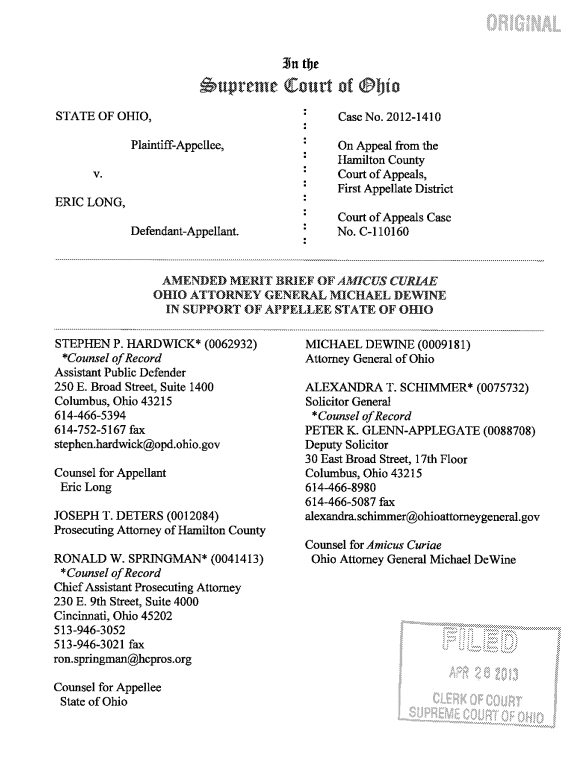
Summary of Argument
Ninety-seven days before Eric Long's eighteenth birthday, he and two companions murdered Scott Neblett and Keith Cobb. The aggravated murders were part of a run of criminal behavior that would also result in three felonious-assault charges and several weapons charges for Long. Given the seriousness of the offenses and the likelihood that Long would commit future crimes, the trial court exercised its discretion to sentence Long to life imprisonment without the possibility of parole. After his sentencing, the United States Supreme Court decided Miller v. Alabama, 567 U.S. _, 132 S. Ct. 2455 (2012), which held that "mandatory life- without-parole sentences for juveniles violate the Eighth Amendment." Id at 2464. Long believes that Miller renders his sentence unconstitutional and entitles him to a new sentencing hearing. He is wrong for three reasons.
First, Long did not receive his life-without-parole sentence under a mandatory scheme. Instead, Ohio law vested the trial court with discretion to sentence Long either to life without the possibility of parole or to life with the possibility of parole after a definite term. The fact that the trial court had discretion in sentencing Long-and that a life sentence was not mandatory-takes Long's sentence outside the scope of Miller, which "h[e]ld that mandatory life without parole for those under the age of 18 at the time of their crimes" violates the Eighth Amendment. Id. at 2460 (emphasis added). Miller simply does not govern here.
Second, Long misreads Miller as additionally requiring a trial court to discuss a juvenile offender's youth on the record before sentcncing him to life without parole. Miller requires sentencers to "consider[] an offender's youth and attendant characteristics" before imposing a life-without-parole sentence, at least where the offender raises the issue. Id. at 2471. But it does not require-nor does any other United States Supreme Court case require-consideration on the record. What is more, Miller drew much of its reasoning from the Supreme Court's capital sentencing cases. Those cases, too, establish no requirement of on-the-record consideration. In brief, Long has absolutely no authority for his theory that sentencers must address juvenile homicide offenders' youth explicitly on the record.
Third, in any event, the record in this case plainly shows that the trial court did consider the mitigating effects of Long's youth before imposing sentence. For starters, Ohio law presumes that sentencers have considered all relevant arguments unless the defendant presents clear evidence to the contrary. Here, Long offers no indication that the trial court misapprehended his argument or misunderstood its relevance. Furthermore, the record is full of evidence that the court considered his youth. Long's sentencing came after the trial judge had presided over his trial for four weeks, which itself suggests that she knew Long was 17 when he committed the two aggravated murders. In case his age was somehow lost on the trial court, Long devoted every word of his sentencing memorandum to the mitigating effects of youth. The memorandum contained no other mitigating arguments. The State, for its part, also acknowledged Long's youth in its sentencing memorandum, arguing that although Long was a
juvenile at the time of the murders, the seriousness of his crimes and his likelihood of recidivism outweighed the mitigating force of his youth. At the sentencing hearing, both Long's counsel and the State orally discussed Long's youth as a mitigating factor. And the trial judge said that she had considered Long's "history, character and condition" before imposing a life-without- parole sentence. Beyond any doubt, the trial court considered Long's youth before sentencing him.
Because Long's sentence does not violate the Eighth Amendment, the Court should affirm.